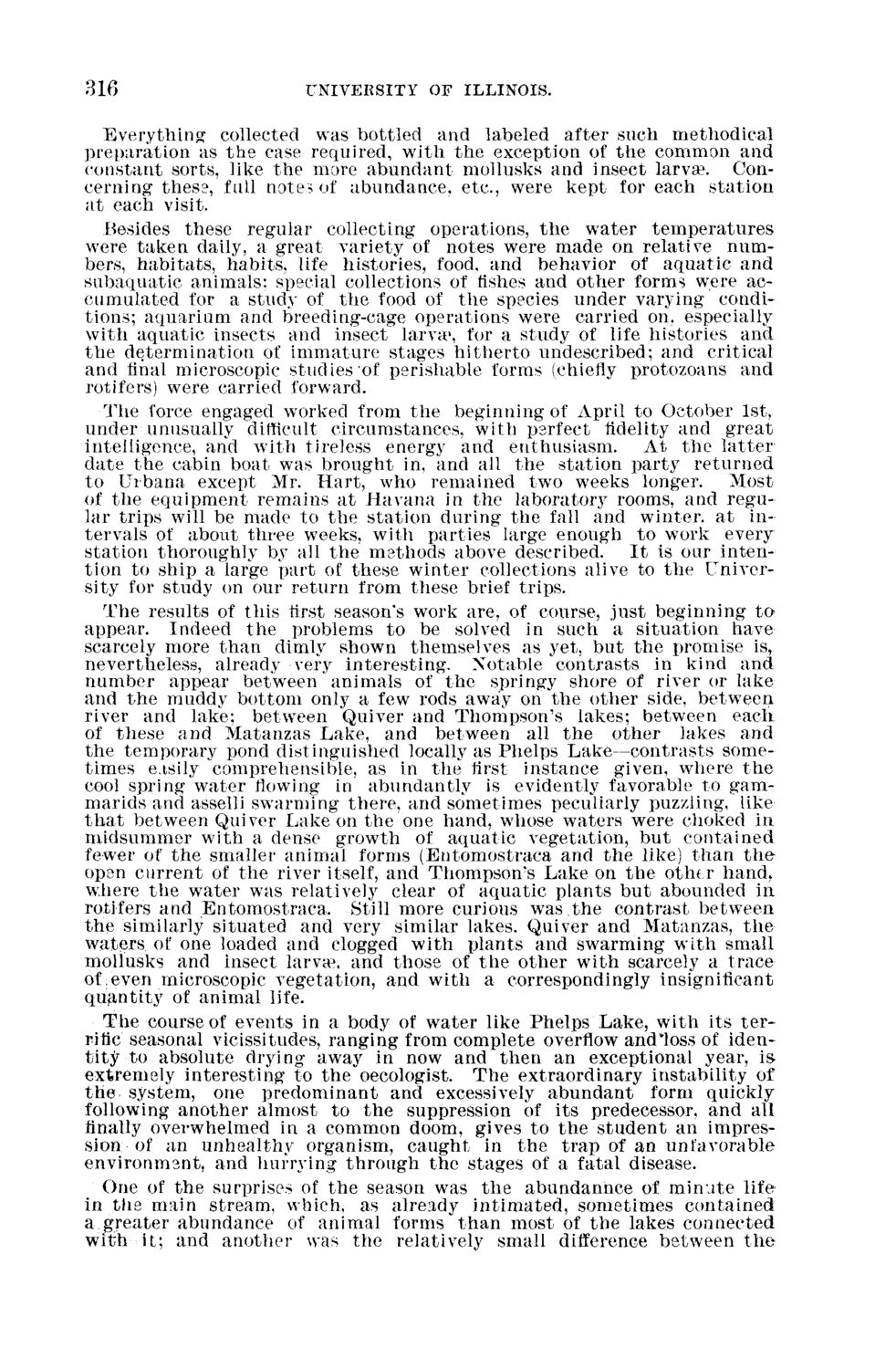| |
| |
Caption: Board of Trustees Minutes - 1894
This is a reduced-resolution page image for fast online browsing.

EXTRACTED TEXT FROM PAGE:
316 UNIVERSITY OF ILLINOIS. Everything collected was bottled and labeled after such methodical preparation as the case required, with the exception of the common and constant sorts, like the more abundant mollusks and insect larvae. Concerning- these, full notes of abundance, etc., were kept for each station at each visit. Besides these regular collecting operations, the water temperatures were taken daily, a great variety of notes were made on relative numbers, habitats, habits, life histories, food, and behavior of aquatic and subaquatic animals; special collections of fishes and other forms were accumulated for a study of the food of the species under varying conditions; aquarium and breeding-cage operations were carried on, especially with aquatic insects and insect larvae, for a study of life histories and the determination of immature stages hitherto undescribed; and critical and final microscopic studies of perishable forms (chiefly protozoans and rotifers) were carried forward. The force engaged worked from the beginning of April to October 1st, under unusually difficult circumstances, with perfect fidelity and great intelligence, and with tireless energy and enthusiasm. At the latter date the cabin boat was brought in, and all the station party returned to Urbana except Mr. Hart, who remained two weeks longer. Most of the equipment remains at Havana in the laboratory rooms, and regular trips will be made to the station during the fall and winter, at intervals of about three weeks, with parties large enough to work every station thoroughly by all the methods above described. I t is our intention to ship a large part of these winter collections alive to the University for study on our return from these brief trips. The results of this first season's work are, of course, just beginning to* appear. Indeed the problems to be solved in such a situation have scarcely more than dimly shown themselves as yet, but the promise is, nevertheless, already very interesting. Notable contrasts in kind and number appear between animals of the springy shore of river or lake and t h e muddy bottom only a few rods away on the other side, between river and lake; between Quiver and Thompson's lakes; between each of these and Matanzas Lake, and between all the other lakes and the temporary pond distinguished locally as Phelps Lake—contrasts sometimes easily comprehensible, as in the first instance given, where t h e cool spring water flowing in abundantly is evidently favorable to gammar ids and asselli swarming there, and sometimes peculiarly puzzling, like t h a t between Quiver Lake on the one hand, whose waters were choked in midsummer with a dense growth of aquatic vegetation, but contained fewer of the smaller animal forms (Entomostraca and the like) than t h e open current of the river itself, and Thompson's Lake on the other hand, where the water was relatively clear of aquatic plants but abounded in rotifers and Entomostraca. Still more curious was the contrast between the similarly situated and very similar lakes. Quiver and Matanzas, the waters of one loaded and clogged with plants and swarming with small mollusks and insect larva^, and those of the other with scarcely a trace of;even microscopic vegetation, and with a correspondingly insignificant quantity of animal life. The course of events in a body of water like Phelps Lake, with its terrific seasonal vicissitudes, ranging from complete overflow andloss of ident i t y to absolute drying away in now and then an exceptional year, isextremely interesting to the oecologist. The extraordinary instability of t h e system, one predominant and excessively abundant form quickly following another almost to the suppression of its predecessor, and all finally overwhelmed in a common doom, gives to the student an impression of an unhealthy organism, caught in the trap of an unfavorable environment, and hurrying through the stages of a fatal disease. One of the surprises of the season was the abundannce of minute life in the main stream, which, as already intimated, sometimes contained a greater abundance of animal forms than most of the lakes connected with it; and another was the relatively small difference between t h e
| |